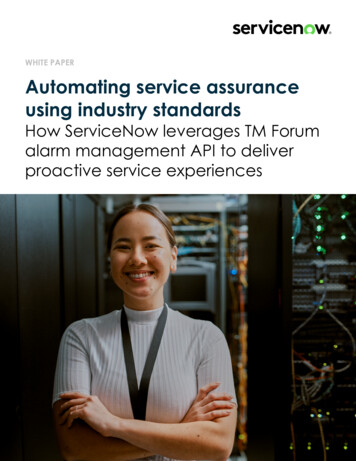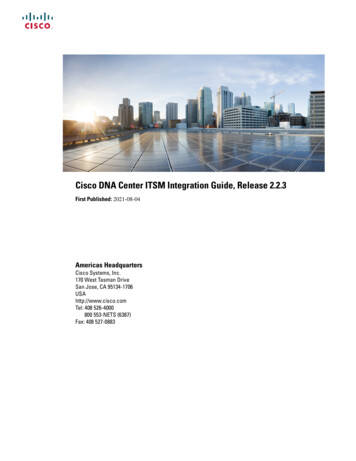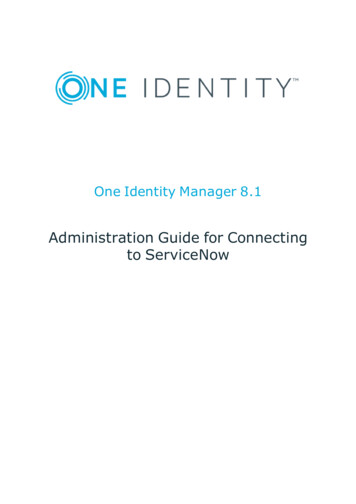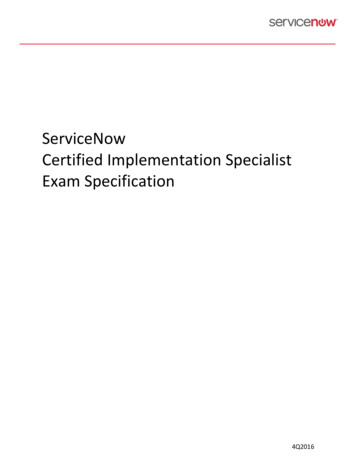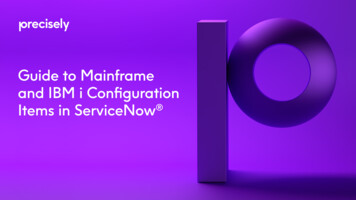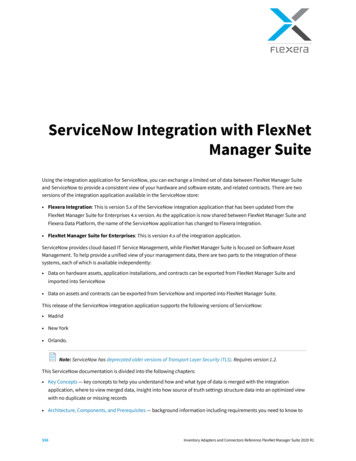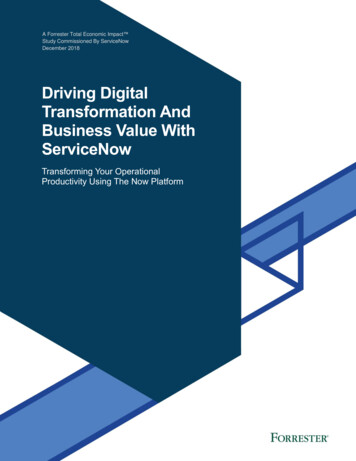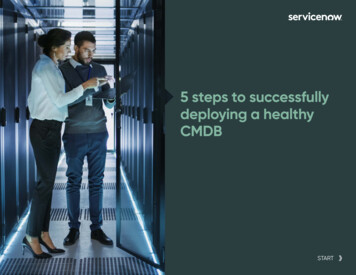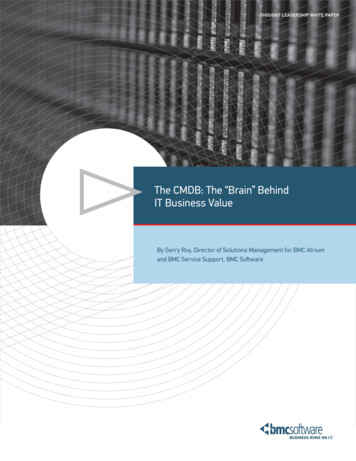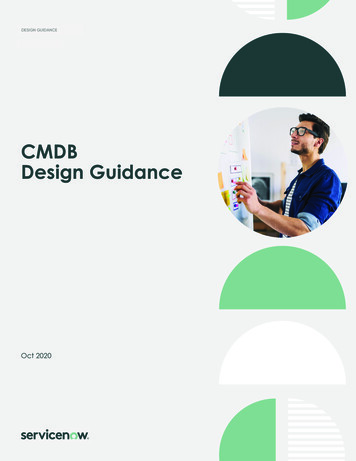
Transcription
DESIGN GUIDANCECMDBDesign GuidanceOct 2020
DESIGN GUIDANCEIntroductionWelcome!In this guide, you’ll find practical advice on how to design and deploy your Configuration Management Database (CMDB). We’ll cover overall design principles,specific implementation steps, and best practices for rolling out and maintainingyour CMDB. By following this guidance, you’ll maximize the business value of yourCMDB, get better results faster, and avoid common pitfalls.This guide is not a marketing document. It assumes you already know the valueof a CMDB and are looking to get started on implementation. If you do need abetter understanding of the benefits of a CMDB or want help explaining thesebenefits to your organization, please talk to your ServiceNow accountrepresentative.One word of advice. Some people worry that implementing a successful CMDB isa complex—or even overwhelming—task. It isn’t. CMDB implementations typicallyfail because people aren’t clear on their objectives or try to go for a “big bang”approach. If you take a structured “crawl, walk, run” approach, you’ll begin tosee benefits very quickly.That’s what this guide will help you to do. Let’s get started.2
DESIGN GUIDANCEA CMDB refresherBefore we dig into design principles, implementation steps, and operational bestpractices, let’s take a moment to review the basics. What is a CMDB, and howdoes it work? Although this guide assumes that you know the value of a CMDB,it’s important to clearly understand its role. This will help you to take full advantageof your CMDB while avoiding the consequences of poor implementation.The purpose of a CMDBThe purpose of a CMDB is to provide accurate and reliable information aboutdigital services and the infrastructure that supports them. In essence, it is thecontent management system (CMS) for ITIL service configurationmanagement—formerly service asset configuration management (SACM).Now that we’ve got the formal definition out of the way, let’s tackle a commonmisperception. Because the CMDB is a configuration management database,people often assume that its primary purpose is to support change management.However, the CMDB’s true purpose is to help you deliver data-driven businessoutcomes, both within IT and more broadly across the business. It has little or novalue if it is just a master data repository—to create value, you have to dosomething useful with the data.Let’s look at a common scenario: a service outage. An application isn’t responding,and hundreds of users are affected. How do you figure out what’s wrong andget the service back up and running quickly? Has someone upgraded theapplication recently? Is it the server, or is there a problem with a databasehalfway around the world? Is there a network problem? So many possibilities,and so little time. Without a CMDB, you don’t even know the application version,which server it’s running on, or which databases it’s talking to. You spend hoursgathering information—assuming that you can find it—and meanwhile the clockis ticking. At this point, the value of a CMDB becomes painfully obvious. It givesyou instant access to the information you need to quickly resolve the serviceissue, including infrastructure relationships, service topologies, change histories,software versions, and more.This is just one example. A CMDB can help you to drive positive business outcomesacross a wide range of operational processes. It can also support and improvemany other business areas—for example, it can help you to reduce servicedelivery costs, maximize the ROI of your application portfolio, and acceleratetime-to-market for new services.Configuration items, attributes, and relationshipsExactly what type of information does a CMDB contain? Here’s a quick recap: As we just said, a CMDB provides accurate and reliable information aboutdigital services and the infrastructure that supports them. To do this, the CMDB stores information that describes components—“things”—in your operational environment that are involved in the delivery of digitalservices. Each component is represented as a configuration item (CI). Each CI has multiple attributes that contain specific information about thecomponent the CI represents. CI classes are arranged in a class hierarchy,with each subclass extending the attributes of its parent class. For example,a Linux Server CI class inherits all of the attributes of its parent Server class andadds Linux-specific attributes. CIs also have relationships. For instance, an application can run on a server,or a web server can depend on an upstream load balancer. The CMDB storesthese relationships between CIs, along with the relationship type (depends on,runs on, etc.).3
DESIGN GUIDANCE Note that these relationships are not the same as the class hierarchy—thehierarchy specifies inheritance between CI classes, whereas relationships arebetween CI instances (e.g. web server “X” depends on load balancer “Y”). CIs can be broadly grouped into two main categories—infrastructure CIs andservice CIs. Infrastructure CIs represent capabilities provided by physical or logicalcomponents such as servers, routers, application software, cloud resources,and so on. Service CIs represent digital services and are supported by infrastructure CIs.In ServiceNow, there are three types of service CIs, representing business,application, and technical services.- A business service supports a business capability—such as managingcustomer orders—and is consumed by business users. Business services aretypically underpinned by one or more application services (i.e. a businessservice can include multiple applications).- An application service is a full application stack—for example, a stockinventory system that supports the customer order management businessservice described above. It isn’t just the application—it’s all of thedistributed components that make the application work. This is what wetypically think about when we talk about a digital service.- A technical service is a technical capability that underpins one or moreapplication services. For instance, multiple application services—includingthe stock inventory system above—could all use a common storage service.Four more things to remember about configuration itemsWe’ve already talked about infrastructure and service CIs. Here are four morethings about CIs that you need to know before you start out on your CMDB journey. CIs must have a unique name that doesn’t change. The name needs to beunique so it can be differentiated from other CIs, and it mustn’t change sothe CI can be tracked over time. For example, using a hostname to uniquelyidentify a server is fine provided that the hostname doesn’t change. On theother hand, it’s a bad idea to use an IP or MAC address to identify a server asthis can easily change—for example, if you’re using dynamically assigned IPaddresses or need to swap out a network interface. CIs must have relationships. An infrastructure CI represents a component thatneeds to be managed to deliver or support a service. In other words, eachinfrastructure CI has a direct or indirect relationship with one or more serviceCIs. For example, a service could have a “depends on” relationship with aweb server CI, while the web server in turn has a “runs on” relationship with aLinux server CI. CIs and assets are related, but they’re not the same. For instance, consider aphysical server that you have purchased. This is tagged and recorded as anasset. Once the server becomes operational, a CI record is created in theCMDB to represent the operational capability provided by the server. The CI—not the asset record—is then referenced in incidents, change requests, andso on. CIs can also exist without corresponding assets—for example, a cloudbased server is represented in the CMDB as a CI, but there is no correspondingasset record since the server does not physically exist. Don’t create CIs for things you can’t configure or monitor. Ask yourself whethera CI could be the subject of an incident or change request. If the answer isno, then don’t create the CI. More specifically, don’t create CIs for passivedatacenter components such as racks. The CMDB is there to help you deliverdigital services—it isn’t a datacenter infrastructure management (DCIM) tool.These types of CIs will just clutter up your CMDB, requiring additional time andeffort to manage without providing any significant value. Keep in mind thatonce a CI has been created it will always be a CI.4
DESIGN GUIDANCEService mappingNow, let’s talk briefly about service maps. As previously mentioned, service CIsrepresent digital services and are supported by infrastructure CIs. Understandingthe relationship between service CIs and supporting infrastructure CIs is criticallyimportant. For instance, it helps you to diagnose the root cause of service issues.A service map in the CMDB captures these relationships, showing which CIssupport the service and how they are related to other CIs.Of course, the CMDB already captures relationships between infrastructure CIs,so how are service maps different?To explain, a service map is a collection of relationships and CIs that representshow a specific application service is delivered. It’s a subset of the CIs and relationships in the CMDB.Let’s revisit the “web server X depends on load balancer Y” example. In fact,many different web servers might depend on the load balancer Y—web serversA, B, C, D, and X, for instance. However, only web server X is involved in deliveringa specific service. While dependencies may exist with the other four web servers,they are used by completely different services.In this case, the service map only includes the X to Y dependency relationship. Ingeneral, a service map only includes the CIs and relationships that are involved inthe specific service, showing how the service flows across your operationalinfrastructure.You have probably come across the terms “horizontal” and “vertical” discovery.Horizontal refers to populating all of the point-to-point relationships betweenCIs—for example, discovering all web servers and load balancers and theirdependencies. This gives you a view of how your infrastructure is configured, aspreviously described in “Configuration items, attributes, and relationships” above.Vertical refers to creating a service map by taking a vertical cut of CIs andrelationships that represent the end-to-end service.The CMDB, Service Graph, and the Common Service Data ModelAs a member of the ServiceNow community, you may have heard about ServiceGraph and the Common Service Data Model (CSDM). If so, you’re probablywondering what this means for your CMDB.Service Graph is ServiceNow’s next-generation system of record. Historically, theCMDB has focused on managing infrastructure, assets, and their relationships.However, ServiceNow customers now want a consistent, data-driven approachto managing the entire digital lifecycle, including planning, application development, deployment, performance, cost, business processes, and other areas.Service Graph provides this by implementing the CSDM, a comprehensive datamodel that covers the complete digital lifecycle. You can think of the CSDM asService Graph’s data schema, in the same way that the CMDB has a data schema.Here’s the good news. As we said, Service Graph is an evolution of the CMDB. BothService Graph and the CSDM are backwards compatible with the CMDB, so none ofyour CMDB investment will be lost. In fact, as Service Graph continues to evolve, it willmake your CMDB easier to manage and give you powerful new capabilities.Service Graph and the CSDM also provide enhanced data governance—prescriptive guidance on how to populate data in Service Graph. Even if you’re notplanning to use the full capabilities of Service Graph today, we strongly recommendthat you follow this same guidance when implementing your CMDB. This willreduce risk and improve the quality of your CMDB, and it will also position you totake full advantage of Service Graph in future. The information provided in thisdocument is aligned with this guidance.5
DESIGN GUIDANCEWhat about DevOps?While DevOps is driving fundamental changes in the way IT organizations deliverdigital services, DevOps teams still need visibility of their operational environment.In fact, they face an even bigger challenge than traditional development teams.They often have to deliver multiple software releases every day while minimizingservice issues and still ensuring appropriate governance. And, as the nameimplies, they need to bridge the gap between development and operations,creating a unified whole. The need for a dynamic, accurate CMDB is greaterthan ever.This document is not intended to address these issues—it’s designed for IT organizations starting out on their CMDB journey. However, ServiceNow does providecomprehensive solutions for DevOps that seamlessly extend ServiceNow’s CMDBcapabilities. With these solutions, DevOps teams can ensure effective governancewithout compromising agility and speed, create real-time visibility of microservicearchitectures, identify the root cause of service failures, manage CI/CD pipelinequality and performance—including organizational performance—and more.If you would like further information about ServiceNow’s DevOps capabilities,please talk to your ServiceNow account representative.6
DESIGN GUIDANCECMDB business andorganizational principlesNow that we’ve recapped the basics—and hopefully given you some insightsinto other areas such as Service Graph—let’s talk about the business andorganizational principles that will maximize your opportunity for CMDB success.Identify areas where your CMDB can deliver business valueAs we’ve already said, if your CMDB is just a master data repository, it has limitedvalue. A CMDB delivers business value, so it needs to support both the strategicobjectives of your business as a whole and the tactical goals of your IT organization.This means focusing on the things that matter to your business.Many organizations struggle with the right amount of configuration management.Often, they try to take an all-encompassing approach. Inevitably, this turns out tobe too expensive and time-consuming—no one is willing to spend millions and waityears for a result. Too little configuration management is just as bad. Withoutsufficient information, you’re unable to properly support your business needs anddeliver meaningful improvements. Your CMDB will end up being regarded as anexpensive and worthless white elephant.So, using a Goldilocks metaphor, how do you avoid the hot and cold porridgeand go straight for the one that’s just right? Don’t assume you know what’s justright. Engage with business stakeholders to identify areas where your CMDB canmake a significant difference. In general, look for initiatives that will improveproductivity, reduce costs, or increase employee satisfaction—these types ofinitiatives usually have the biggest business traction.For example, are you being hit with big penalties for software license noncompliance? Or are you having too many service outages? If so, which servicesare affected and what’s the impact on productivity? Are your employees fed upbecause their issues are bouncing around between IT support teams? Perhapsyou’re starting a cloud migration and need to know which services to movefirst—and how to move them. This isn’t a comprehensive list; you’ll find your ownopportunities and challenges that you can address with your CMDB.Again, remember you’re not trying to boil the ocean. Don’t spend a hugeamount of time identifying every possible use case. Come up with a top ‘N’ listand prioritize it. Things to consider when prioritizing include: Quantified benefits—for example, how much money will you save? Amount of effort—what’s the return on investment and do you havethe resources? Timeline—will this deliver a quick win for your business? Risk—how complex is it, what could go wrong, and what are the unknowns? Support from the business—is someone asking for this and are they willing togo to bat for it?If you’re looking for an executive sponsor for your CMDB initiative, you may alsowant to prioritize use cases that deliver specific benefits for your target sponsor.One last word on this—you may be tempted to draw up a comprehensiveconfiguration management plan (more on that in a minute) before you engagethe business. The choice is yours, but consider this. Until you have businessalignment, that next level of detail is likely to change and be wasted. You needto give your business enough information to make decisions—and you have tohave confiden in that information—but you don’t need to have everythingplanned up front.7
DESIGN GUIDANCEThink about data and processesAs we said at the start, the role of a CMDB is to provide accurate and reliabledata about digital services and the infrastructure that supports them. In somecases, this data alone delivers value—for example, providing an inventory ofdeployed software licenses. However, you create much more value when youuse this data to help drive and automate business processes. Sticking with thesoftware asset management example, it’s interesting to know what software isdeployed, but it’s even more useful to be able to reconcile these licenses withyour purchased license entitlements—or to automatically reclaim licenses so youcan reuse them.Obviously, the role of your configuration management team is to provide thedata that fuels these processes. However, unless these processes exist and havean owner, you’re wasting your time. Identify process owners and work with themto define a solution that combines data and processes—and use ServiceNow toautomate these workflows. That’s what ServiceNow excels at, and it’s how you’llmaximize the value of your configuration data. And, if you don’t want to buildthe workflows yourself, work with the process owner to identify resources that canbuild them for you.You’ll also be asked to participate in strategic technology projects. It’s importantto devote resources to these projects early on so you can assess any changesthat are needed to your configuration management capabilities—for example,additional CIs, new data sources, or enhanced reporting capabilities. This isreferred to in configuration management parlance as “project tailoring”. You’llneed to feed these requirements back into your prioritized list of configurationmanagement initiatives, making it a living roadmap rather than a static to-do list.Organizing for successNow that you have initial business alignment on what you’re going to do, it’s timeto plan how you’re going to do it. We’re not talking about technical executionhere (that comes next). Instead, let’s look at the organizational and planningaspects of successfully launching your CMDB.We’ll start with governance. Some organizations formalize their configurationmanagement governance structure by creating a Configuration Control Board(CCB), in much the same way that many IT organizations have a Change AdvisoryBoard (CAB). Creating a CCB does promote success, but it’s a significantundertaking that is, quite frankly, better suited to large organizations with matureand extensive configuration management processes. If you’re just starting out onyour journey, creating a CCB may be too big a hurdle—and many IT organizationsnever create a CCB at all.So, what’s the alternative to creating a CCB? How do you start out lean and stillachieve success? There are two key elements: Clearly define roles and responsibilities, not just within your configuration management team, but across the business. Get alignment on this, and make sure thatthe business is going to support you. For example, it’s no use having everyonenod when you say you need a business owner—get a name and a commitment. Create a Configuration Management Plan (CMP). Think of this as your programblueprint. This needs to be comprehensive, but it also needs to be flexible. There’sno point locking yourself into a three-year program in minute detail—you’regoing to need to update and evolve your plan as business priorities change.Let’s look at each of these points in turn.8
DESIGN GUIDANCEDefining roles and responsibilitiesThink about how you want to distribute your configuration management processes.Do you want a central team to handle everything, or do you plan on havingindividual teams? For example, will your storage team look after their ownconfiguration management? Or do you want a hybrid model, with distributedteams feeding into a central team?Here are some things to consider before making this decision: If you have a centralized team, you’re still going to have to engage manysubject matter experts. This is particularly true if you are dealing with on-premisesinfrastructure and plan to populate your CMDB manually (as opposed to automating discovery with ITOM Visibility). This requires strong project buy-in fromyour stakeholders and heavy project management. Even if you do automaticallydiscover your infrastructure, you’ll still need to engage subject matter expertsto validate that the deployed infrastructure matches the intended design.Otherwise, as we said before, all you have is a master data project with nobusiness outcomes. Distributed teams do have advantages. With a number of small, distributedteams, each team can make quick decisions and take responsibility forresolving issues. And, because each team is also a CMDB client—they use theCMDB data—they are best positioned to prioritize what data goes into theCMDB. And, if you are using discovery, the burden on these teams can bequite light since the CMDB is updated automatically. Many ServiceNow customers opt for a hybrid model. Even with discovery,distributed teams often don’t have all the expertise needed to maintain theirslice of the CMDB. For example, functions such as security span your entire ITinfrastructure—and it’s unrealistic to expect each team to have its own securityexpert. The same thing goes for monitoring, software asset management, andmany other functions that depend on the CMDB. A hybrid model thatcombines centralized core competencies with the domain expertise ofdistributed teams often provides the best balance, and it also ensures processconsistency and uniform governance.Creating and maintaining a Configuration Management PlanAs with any major initiative, you need a clearly defined, structured and documented plan to succeed. In the case of configuration management, this is referredto—unsurprisingly—as a Configuration Management Plan (CMP). This needs tobe a top priority once you have initial business agreement on your goals andobjectives and have built a prioritized list of configuration managementinitiatives.Here are some examples of things that your CMP should include: Purpose: Why have you created the plan and how do you intend it to be used? Goals and objectives: What are you trying to accomplish as per your agreement with the business? Provide a list of well-defined goals and associatedsuccess criteria. Scope: What does the plan cover? For example, is it just for productionenvironments, or do you also intend to provide configuration managementfor development and test? Roadmap: What will you deliver, and when? Applicable policies, standards, and processes: Which policies, standards andprocesses will you follow as you execute your configuration management plan? Roles and responsibilities: Document roles and responsibilities you have defined.This needs to cover your configuration management team, as well as anyroles you interact with—for example, application owners or business owners.A RACI matrix is a good way to do this.9
DESIGN GUIDANCE Governance: What are your governance processes? As already mentioned,you don’t necessarily need to have a Configuration Control Board, but youdo need some mechanism for making decisions and ensuring that things stayon track.This isn’t a comprehensive list. You’ll want to add other things such as communications and training strategies, verification, and audit processes, how you respondto data integrity issues, and so on. Your plan should be sufficiently complete thatsomeone else can pick it up and understand how you do configuration management—both your current state and your planned future state. However, don’tovercomplicate your plan unnecessarily. If you build in too much detail, yourplan will become inflexible, and you’ll end up making major revisions every timethere’s a new business requirement. Remember, your top priority is to deliverbusiness value, not to spend your time buried in documentation.One last point on your CMP. This is a perfect place to clearly define your terminology. This is extremely important since you need an agreed common languageto talk about configuration management. Otherwise, you’ll end up havingmisunderstandings, which will inevitably lead to misaligned expectations andpoor execution.If you’re looking for more inspiration for your CMP, you’ll find a sample CMP outlinein Appendix A. Obviously, you’ll need to tailor this to your own specific needs, butit’s a good checklist of the things you need to consider.10
DESIGN GUIDANCECMDB design principlesNow let’s shift gears and talk about how to design your CMDB. How do you decidewhat information to store in your CMDB, and how do you structure that information?Design with the end state in mindPut simply, if you don’t know where you’re going, you’re never going to get there.Create a clear picture of what you want to achieve and align your design withthis target. Obviously, this includes the type of configuration data you’re going tomanage, but it’s more than that. Ultimately, this data has to be useful and understandable. In fact, this is probably the single most important success criterion.Think about who—or what—will use this data. For example: Does it need to flow into other ServiceNow processes? While these processesare designed to work out of the box with the CMDB, you still need to ensurethe data meets your specific requirements. For instance, how fast do youneed to discover infrastructure changes to support Event Management—do you have a relatively stable environment with infrequent changes, or isit highly dynamic? If people are using the data directly, how does it need to be visualized? Forinstance, all screens and reports need to be easily understandable and havea similar design. And each field must have a single defined purpose—don’tchange the meaning of fields depending on the context.Align your data with your use casesOf course, to design for the end state, you need to collect the right data. Thismay seem obvious, but your data needs to support your desired outcomes—thegoals and objectives you agreed to with your business.What exactly do we mean by aligning your data with desired outcomes? Here’san example. If your top priority is to reduce software costs, you’ll want to collectinformation about your deployed software applications. It doesn’t make sense totry to map your services in this case. What would you do with service maps? Onthe other hand, if you want to migrate services to the cloud, service maps arecritical—they show you what components need to move, and they help you toavoid breaking services when you move them.Make a list of the CIs and relationships that you need, along with the specificattributes that support your use case. Once you have this list, figure out whereyou can get the corresponding data. Again, this may seem obvious, but it willhelp you to focus your data gathering strategy. For instance: What information can you collect directly from your IT environment? You candiscover this type of data using ServiceNow ITOM Visibility. This includesinfrastructure configuration, infrastructure relationships, and service maps. Which information do you need to bring in from third-party systems? Forexample, if you are working on a security use case, you might want to enrichCIs with information from vulnerability scanners. You can import this type ofdata using Integration Hub ETL, either by creating your own integration orusing an existing integration from the ServiceNow Store. What information isn’t discoverable or available from third-party systems? You’llneed to set up processes to collect this data manually and keep it up to date.One example of this type of data is organizational information. For instance,who owns a specific service?At this point, also decide which CI attributes need to be put under changemanagement. Obviously, discovered attributes and attributes imported from thirdparty systems don’t need to be put under change management from a pureconfiguration management perspective—the data is what it is and no one canupdate it manually in the CMDB.11
DESIGN GUIDANCEHowever, there may be separate operational change management processesassociated with this data—for example, someone may need an approved changerequest to upgrade a software application. In these cases, you should beprepared to track changes to associated attributes—the application softwareversion in this case—so that other teams can detect unplanned or unauthorizedchanges.That leaves non-discoverable attributes: for example, the business owner of aparticular digital service. Be selective when you decide which of these needs tobe under change management from a configuration management perspective.Only choose those that are important since each attribute under changemanagement creates additional work.Out-of-the-box vs. custom CI classesThe ServiceNow CMDB comes with a rich set of out-of-the-box CI classes. Whereverpossible, use these out-of-the-box classes as is—you’ll save significant effort andsimplify upgrades. Also keep in mind that these CI classes are designed to workseamlessly with other ServiceNow apps, so when you use out-of-the-box CIs, youhave access to the full power of these apps.However, you may come across cases where out-of-the-box CIs aren’t sufficient—for instance, if you have a custom application or wa
The CMDB, Service Graph, and the Common Service Data Model As a member of the ServiceNow community, you may have heard about Service Graph and the Common Service Data Model (CSDM). If so, you're probably wondering what this means for your CMDB. Service Graph is ServiceNow's next-generation system of record. Historically, the
